
Shakamak State Park is a state park in Indiana, United States. It is located 30 miles (48 km) southeast of Terre Haute, Indiana.

Beverly Shores is a train station in Beverly Shores, Indiana, served by the South Shore Line interurban commuter railroad. The station serves the town of Beverly Shores as well as the nearby Town of Pines. It is a flag stop.
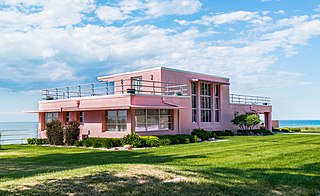
The Century of Progress Architectural District is a historic district in Beverly Shores, Indiana. The district is on Lake Shore Drive within the Indiana Dunes National Park. The district comprises five buildings, all from the Homes of Tomorrow Exhibition of the 1933 Century of Progress World's Fair which took place in Chicago. Intended to display the future of housing, the Century of Progress Homes reflect a variety of designs, experimental materials and new technologies. On June 30, 1986, the district was listed on the National Register of Historic Places as the Beverly Shores–Century of Progress Architectural District.

Forest Hills Historic District is a national historic district located at Indianapolis, Indiana. It encompasses 173 contributing buildings and 7 contributing structures in a planned residential section of Indianapolis. It developed between about 1911 and 1935, and includes representative examples of Tudor Revival and English Cottage style architecture.

Morningside Historic District is a national historic district located at Gary, Indiana. The district is characterized by spacious lots and tree-shaded curving streets. It encompasses 99 contributing buildings and 1 contributing site.

Marktown is an urban planned worker community in East Chicago, Indiana, United States, built during the Progressive Era in 1917 from marshland to provide a complete community for workers at The Mark Manufacturing Company.

Chesterton is a disused train station in Chesterton, Indiana. The current depot replaced a wooden structure built in 1852 for the Northern Indiana and Chicago Railroad, a predecessor road of the Lake Shore and Michigan Southern Railway, that burned down in 1913. It was rebuilt in 1914 as a brick structure. By 1914, Cornelius Vanderbilt of the New York Central and Hudson River Railroad held a majority interest in the Lake Shore and Michigan Southern Railway. The Southern Railways trackage provided an ideal extension of the New York Central from Buffalo to Chicago. On December 22, 1914, the New York Central and Hudson River Railroad merged with the Lake Shore and Michigan Southern Railway to form a new New York Central Railroad.
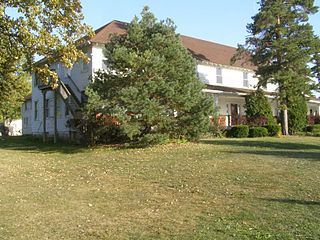
Lassen Hotel is a historic hotel building located at 7808 West 138th Place in Cedar Lake, Lake County, Indiana. It is a two-story, "T"-shaped frame building sheathed in clapboard. It has a hipped roof and features a wraparound verandah overlooking Cedar Lake. The eastern section of the building was built about 1890. It was moved to its present location during mid-winter of 1919 and the lakefront section was built onto it in 1920. Its grand opening was on May 7, 1921. It is home to the Red Cedars Lake History Museum, now the Museum at Lassen's Resort on Cedar Lake. A restoration project was underway in 2013. It was listed in the National Register of Historic Places in 1981.
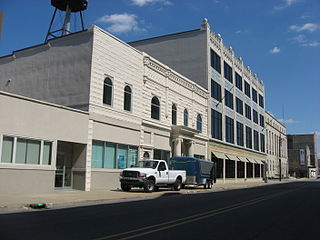
State Street Commercial Historic District is a national historic district located at Hammond, Lake County, Indiana. The district encompasses 28 contributing buildings in the central business district of Hammond. It developed between about 1885 and 1946, and includes notable example of Commercial, Classical Revival, Late Gothic Revival, and Art Deco style architecture. Notable buildings include the L. Fish Building (1927), Federal Building (1939), Lincoln Hotel (1923), Seifer Building (1925), and the Henderson Building (1902).
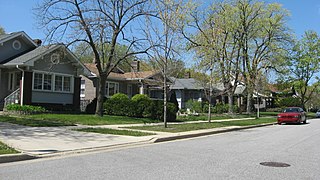
Forest–Moraine Residential Historic District is a national historic district located at Hammond, Lake County, Indiana. The district encompasses 108 contributing buildings in an exclusively residential section of Hammond. It developed between about 1913 and 1950, and includes notable example of Renaissance Revival, Colonial Revival, Tudor Revival, and English Cottage style residential architecture.
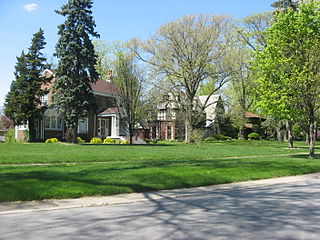
Forest–Southview Residential Historic District is a national historic district located at Hammond, Lake County, Indiana. The district encompasses 39 contributing buildings and 1 contributing site in an exclusively residential section of Hammond. It developed between about 1912 and 1949, and includes notable example of Renaissance Revival, Colonial Revival, Tudor Revival, and Bungalow / American Craftsman styles of residential architecture.

Glendale Park Historic District is a national historic district located at Hammond, Lake County, Indiana. The district encompasses 13 contributing buildings and 1 contributing site in an exclusively residential section of Hammond. It developed between about 1905 and 1926, and includes notable example of Colonial Revival, Tudor Revival, Prairie School and Bungalow / American Craftsman styles of residential architecture. The houses are arranged along a parkway with Glendale Park in the center.

Indi-Illi Park Historic District is a national historic district located at Hammond, Lake County, Indiana. The district encompasses 93 contributing buildings in an exclusively residential section of Hammond. It developed between about 1923 and 1940, and includes notable example of Colonial Revival, Tudor Revival, Classical Revival, Bungalow / American Craftsman, and eclectic styles of residential architecture.

East Shore Historic District, also known as Lake Maxinkuckee Historic District, is a national historic district located in Union Township, Marshall County, Indiana. The district encompasses 114 contributing buildings, 3 contributing sites, and 1 contributing structure in a resort development along the shore of Lake Maxinkuckee. It developed between about 1873 and 1945, and includes examples of Late Victorian, Colonial Revival, and Bungalow / American Craftsman style architecture. The district includes Maxinkuckee Country Club. Notable buildings include the Norris Farmhouse, Trone Cottage, Roach-Rockwood Cottage, Elliott Cottage, Gates-Holliday Cottage (1897), Marmon Cottage, and Norman Perry House.

F.P. Nelson House, also known as The Towers, is a historic home located at Greencastle, Putnam County, Indiana. It was built between 1871 and 1875, and is a large two-story, Italianate style brick dwelling. It has a low hipped roof and sits on a stone foundation. The house features segmental arched openings, a projecting entrance bay, and two-story polygonal bay.
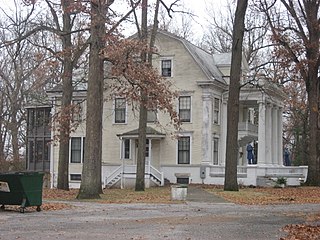
Indiana State Soldiers Home Historic District is a historic Soldiers Home and national historic district located in Tippecanoe Township and Wabash Township, Tippecanoe County, Indiana. The district encompasses four contributing buildings on the campus of the former Soldiers Home. They are the Post Exchange, Commandant's House, Library Building, and the Administration Building. Funding for the home was approved by the Indiana State Legislature in 1888, and building commenced in 1890. Most of the original buildings were demolished in the 1950s. The property continued to be administered by the Indiana Department of Veterans' Affairs as the Indiana Veterans’ Home

Brendonwood Historic District, also known as Brendonwood Common, is a national historic district located at Indianapolis, Indiana. It encompasses 85 contributing buildings, 2 contributing sites, and 1 contributing object in a planned suburban residential section of Indianapolis. 350 acres on the eastern edge of Millersville with Fall Creek as the western boundary was the vision of Charles S. Lewis for a self-regulated residential zone of 110 plots. Noted landscape architect George E. Kessler was hired to develop the planned community. The district developed between about 1917 and 1954, and includes representative examples of Tudor Revival, Colonial Revival, and Bungalow / American Craftsman style architecture. Notable contributing resources include the Common House (1924), golf course, Two Knolls (1951-1952), Farlook (1939), Springhead (1934), Dearwald (1927), Wancroft (1940), Larkwing (1952), Grasmere (1937-1938), Wetermain (1921), Whispering Trees (1952-1953), Glen Gate (1922-1923), Witching View (1928-1929), Long Ridge (1923-1924) and Great Maple (1948).
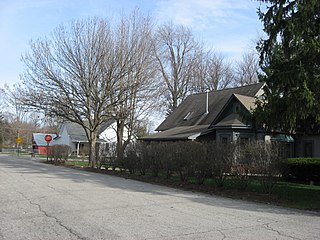
New Augusta Historic District is a national historic district located at Indianapolis, Indiana. It encompasses 114 contributing buildings, 1 contributing structure, and 1 contributing object in a railroad oriented village in Indianapolis. The district developed between about 1852 and 1939, and includes representative examples of Italianate and Bungalow / American Craftsman style architecture. Notable contributing buildings include the Odd Fellows Building, Hopewell Evangelical Lutheran Church, Salem Lutheran Church (1880), and New Augusta Depot. It is located west of Augusta.

Cumberland Historic District is a national historic district located at Cumberland, Indiana. It encompasses 91 contributing buildings in the Cumberland section of Indianapolis. The district developed between about 1831 and 1950, and includes representative examples of Folk Victorian and Bungalow / American Craftsman style architecture. Notable contributing resources include the Cumberland Bank (1907), Masonic Lodge, Miller's Lunch, and First Baptist Church (1912-1913).

Shortridge–Meridian Street Apartments Historic District is a national historic district located at Indianapolis, Indiana. The district encompasses 136 contributing buildings in a predominantly residential section of Indianapolis. It was developed between about 1900 and 1951, and includes representative examples of Colonial Revival, Classical Revival, Late Gothic Revival, Mission Revival, Renaissance Revival, Bungalow / American Craftsman, and Art Deco style architecture. Located in the district is the separately listed Shortridge High School. Other notable buildings include the Vernon Court Apartments (1928), Fronenac Apartments (1951), Biltmore Apartments (1927), Meridian Apartments (1929), New Yorker Apartments (1917), Howland Manor (1929), Powell-Evans House (1911), Harms House (1906), Dorchester Apartments (1921), and Martin Manor Apartments (1916).
























